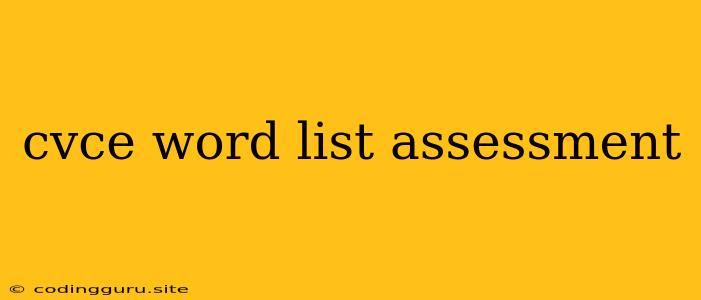Mastering CVCe Words: A Comprehensive Assessment Guide
Learning to read is a fundamental skill that opens doors to a world of knowledge and understanding. One key element in this journey is mastering CVCe words. These words, featuring a consonant, vowel, consonant, and silent "e" pattern, are crucial stepping stones for young learners. This guide will explore the importance of CVCe word lists in assessing reading progress and provide practical tips for effective assessment strategies.
What are CVCe Words?
CVCe words are a unique type of word that follow a specific pattern:
- Consonant (C): The word begins with a single consonant sound.
- Vowel (V): A single vowel sound follows the initial consonant.
- Consonant (C): Another consonant sound comes next.
- Silent "e" (e): A silent "e" at the end of the word changes the vowel sound.
For instance, "cake" is a CVCe word. The "a" makes a long "a" sound due to the silent "e". Understanding this pattern helps children decode words and build reading fluency.
Why are CVCe Word Lists Important for Assessment?
CVCe word lists serve as valuable tools for assessing a child's reading development in a structured and systematic way. They provide a standardized framework for:
- Identifying phonics skills: CVCe word lists assess a child's ability to apply the CVCe pattern and recognize the long vowel sound.
- Tracking reading progress: By assessing performance over time, teachers can monitor improvement and identify areas that require further instruction.
- Tailoring instruction: The results from CVCe word lists can help teachers personalize learning plans and target specific phonics skills.
How to Assess CVCe Words Effectively:
- Choose the right list: Use a CVCe word list that aligns with the child's grade level and reading abilities. Several resources offer age-appropriate lists with increasing difficulty.
- Establish a comfortable environment: Create a calm and supportive atmosphere for the assessment to reduce anxiety and encourage participation.
- Start with familiar words: Begin with simpler CVCe words that the child has likely encountered before. This helps build confidence and sets a positive tone.
- Use different assessment methods: Vary the assessment methods to engage different learning styles. Consider:
- Oral reading: The child reads the words aloud.
- Word recognition: The child points to the correct word from a set of options.
- Picture matching: The child matches words to corresponding pictures.
- Record the results: Keep track of the words the child reads correctly and incorrectly. This data will inform future instruction and guide the learning process.
Sample CVCe Word List:
Beginner level:
- bike
- cape
- cute
- kite
- rope
Intermediate level:
- trace
- flame
- crane
- grape
- smile
Advanced level:
- explore
- devote
- compute
- compose
- achieve
Tips for Enhancing CVCe Word Assessment:
- Focus on sounds: Emphasize the pronunciation of the long vowel sound in CVCe words. Use phonetic cues like "say it like a snake" for the "a" in "cake".
- Visual aids: Use flashcards, posters, or picture books to reinforce the CVCe pattern.
- Interactive activities: Incorporate games, songs, and hands-on activities to make learning fun and engaging.
- Repeated exposure: Provide regular opportunities to practice CVCe words through reading, writing, and word games.
Conclusion:
CVCe word lists are an indispensable tool for assessing reading progress and providing targeted instruction. By understanding the importance of CVCe words and implementing effective assessment strategies, teachers can empower young learners to become confident and fluent readers.
Remember, reading is a journey, and CVCe word lists are just one step on the path to literacy. With patience, guidance, and a focus on the CVCe pattern, every child can unlock the magic of words.
